So photo day week came and went and what a week it was! But now that those early morning, shoot as quick as you can days are behind me, what’s next for baseball team photographers like myself? Plenty! Allow me to explain.

The first week or so of camp is a great time to grab my 14-24, 24-70 and 200-400 and hit the practice fields. I find that this short time period between reporting dates and the first spring games provides the perfect opportunity to make images that really scream spring. You know, interactive images of the coaching staff working with the players or players running through instructional drills that are unique to spring training. Once the regular season starts I have so many other game day projects on my plate that it becomes difficult to get out to make theses images (like coaches coaching), so I make an effort to take advantage of this opportunity every spring.
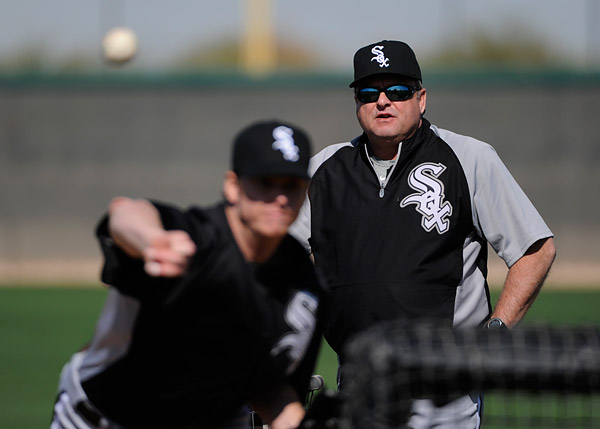
Once the games starts, it’s time to concentrate on the new arrivals and rookies. For the White Sox in 2011, the main new faces for me to watch for are Adam Dunn and Jesse Crain. When camp first opens there are quite a few pitchers on the roster, so there ends up being quite a few “B” and simulated games set up in addition to the regularly scheduled game to make sure everyone gets their work in. Getting my hands on a copy of the projected pitching schedule was important in my quest to photograph Jesse in game action.

Pitchers are typically on a limited pitch count so there might be only one or two opportunities to catch a guy throwing “live” prior to deadline. It was a little easier for me working on Jesse since he is a middle reliever and tends to throw every other day or so, unlike a starter. I prefer to avoid shooting action on the practice field unless the photo is newsworthy (like when Jake Peavy threw for the first time to batters since suffering from a detached latissimus dorsi muscle last summer) because the backgrounds are usually awful and chain link fences abound. Actually, I try like hell to to avoid these backgrounds when ever possible. During spring training, that alone can be a tough task.
Adam Dunn became my 2011 Spring Challenge. I had heard from a few of my colleagues that his swing, powerful and productive as it is, was difficult to capture. How can that be? Well let me tell you. First, Adam seemed very aggressive the first week of camp and came out hacking early in the count. That in itself makes things tough since he may only get three at-bats a game, even as DH. An at bat made up of one swing after one pitch does not provide much of a photo op. Second, remotely reminiscent to how Michael Jordan stuck out his tongue as he did his thing, Adam likes to clench a wad of gum in between his teeth while doing his thing, particularly after making contact or while running.
On a few occasions I thought I made be a nice batting frame on Adam only to sigh in dismay while editing as the clearly visible pink wad of Bazooka stood out, firmly planted between his teeth. Bummer!

Adam also has a high hand follow through which often blocks his face. Now you might get an idea of the mission at hand. Sports Illustrated staff photographer John Biever was also on the “Dunn Hunt” with me and it seemed like a battle was in store to get the image in time for both of us. John visited Camelback Ranch more often than he probably would have liked to, since Camelback was known for it’s bizarre focus (or should I say non-focus issues). More on that in a minute. Impending publication deadlines added to the pressure to make a killer picture. It wasn’t a matter of “if” but “when”, but in our cases “when” had a time limit attached and unfortunately the sand was draining quickly from the hourglass.

We both made some OK pictures, but the standout image we were both looking for was still to be had. That was until Sports Illustrated contributing photographer Brad Mangin came up with a plan to swoop into the mix and make a great Adam Dunn image in one try. And let me say this, although the result of Brad’s shoot has yet to be published, he indeed did swoop in and made the picture! What did he do that John and I didn’t? What was his secret?
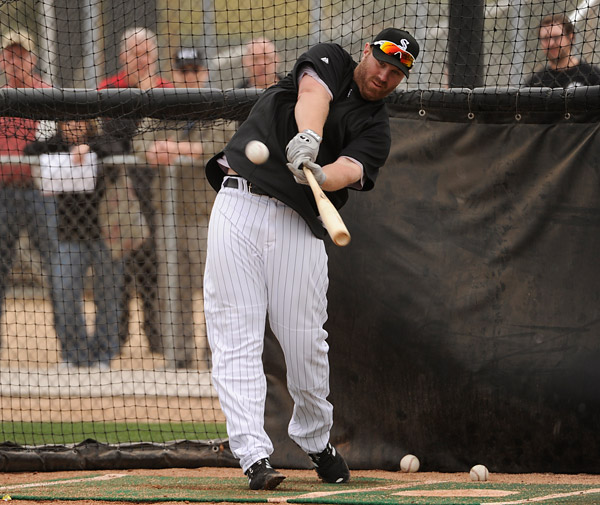
Brad thought outside the box. Shoot from the outfield. Brad has access to a Canon 800 f5.6 lens and set up to shoot Dunn from the right field grassy pavilion at Scottsdale Stadium and bingo, the elusive Adam Dunn killer batting image was made. He showed me three nice frames, all with no hands in front of the face, no gum in between his teeth (because he hadn’t completely turned on the ball yet). It was a perfect strategy and one I plan on implementing once I get home to U.S. Cellular next month.
Spring training as the phrase is defined also applies to photographers. Timing has to be re-discovered, work flow eased back into, anticipation (getting back into the baseball frame of mind) worked on. But like riding a bicycle, it all comes back.

Now let’s talk about the mysterious focus issues of Camelback Ranch that I eluded to earlier. 2011 will be the third year the White Sox have made Camelback Ranch their spring training home, and for the first two, for whatever reason, if the sun was shining (which it happens to do a lot in the desert), very few, and I really stress, very few images would be acceptably sharp once brought into Photoshop. Mind boggling. This behavior acted a lot like those experienced as heat waves, but it didn’t matter if it was 65 or 85 degrees, sharp focus was hard to attain. Canon, Nikon, it didn’t matter what you were shooting, although my Canon toting pals seemed to have more difficultly coping with this issue than us Nikon users. It was just plain bizarre! To add to the weirdness, I made this observation. Around 3pm, it was like someone flipped the on the “sharpness switch” and everything suddenly snapped into razor sharp focus. Unfortunately, the games were nearly over at 3pm! This phenomena drove me crazy since Camelback Ranch would be my spring training home for a very long time. What was causing it?
Well, I have some theories so I’ll float them out there for you to ponder.
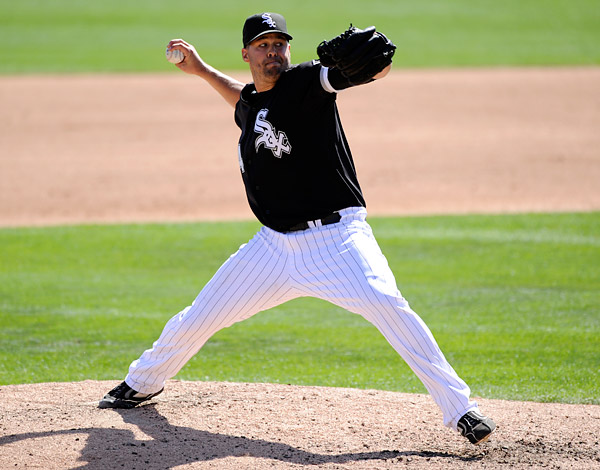
Have you ever noticed that when it’s really dry, you don’t sweat as much? That’s because the moisture (sweat) rapidly evaporates off your skin into the dry (desert) air. Make note of the reference rapidly. Conversely, when the air is moist and humidity is high, the rate of evaporation is much slower (hence why you feel miserable during hot humid weather). Taking these physics observations into consideration, I have come up with my theory as to why Camelback Ranch had been so difficult to focus in. I attributed it to heavy watering of the field pregame which was followed by a nice, hot, dry sunny Arizona afternoon where the conditions were prime for accelerated evaporation of this moisture (the watering of the field), resulting in what I call excessive “thermal movement” (my own terminology, a Vesism) of the air (which now contains quite a bit of vapor, a byproduct of evaporation) near the playing field, and that this thermal movement and resulting excessive vapor was the culprit responsible for the focus mayhem we all experienced. It wasn’t just heat rising, it was heat AND moisture. Very turbulent, vapor laden air at the surface. Although it wasn’t visible to the naked eye, there was vapor to focus through, and that invisible vapor, combined with heatwaves and air movement at the surface added up to nothing but trouble when trying to obtain accurate focus using the high end digital camera auto-focus systems we all use today . Why did things seem to improve around 3pm? More from my over analytical mind. IMO most of the moisture had evaporated by this time, and since the sun was lower in the sky and therefore weaker, the evaporative rate of rise had slowed considerably, thus slowing down the thermal movement and reducing the vapor content of the air near the playing surface. With all the focusing difficulty experienced at The Ranch, I jokingly suggested that perhaps Rob Galbraith might consider performing some of his digital camera tests at Camelback Ranch at noon on game days! If the equipment tested acceptably, it would be like receiving the photography equivalent of the “Good Housekeeping Seal of Approval”.
The good news is that this season, the mysterious focus issues of Camelback Ranch seems to have diminished considerably, if not entirely. Theory? (What, me have a theory? If you haven’t noticed by now, I’ve always got one ready). Perhaps after three seasons the turf is better established and requires less watering, playing into my observation on evaporation rates and the resulting atmospheric makeup (less vapor, less air movement). I don’t know where else to point the blame. Is soil makeup part of the equation too? Perhaps. No other ballpark in the Cactus League exhibited this phenomena like that experienced at Camelback Ranch during 2009 and 2010. Hopefully, the mystery is gone for good. Finally, I can shoot overhead again with a 500 f4 and 1.4 converter with great results. Last season I wouldn’t have dreamed of using that focal length combination except if it was cloudy, maybe. Hooray! I can finally enjoy shooting once again at my own ballpark!
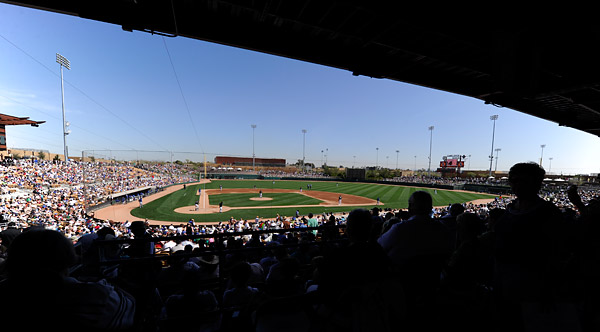
Speaking of enjoying my ballpark, Camelback Ranch is one of the new state of the art spring training facilities in the Cactus League. This season, Salt River Fields at Talking Stick opened up and it is now the bench mark from which all others are compared to. Stunning. I wish I would have had a chance to shoot a game there since the backgrounds have a Major League look to them, the lighting is fantastic, photo boxes built with care and planning. Next year.

Even though the games don’t count, it’s still a great time to get your timing down and head into the game. Pretty nice action does come out of spring training games on occasion. Treat every game like it counts. I think it’s a good habit to get into. I feel that a photographer who tries to turn their thought processes on and off based on if the game means anything will get burned down the road by thinking too much instead of just shooting. Turn it on and leave it on.

The White Sox are one of the few teams that wear their real uniforms in spring training, including caps, every game. A few teams might throw on their game unies for a game here and there (the Twins come to mind) but most wear their batting practice tops and spring issue only caps. Ugh! The photos became dated almost immediately and only useful for spring training or early season projects. They have what I like to call it “no shelf life”. Back in the day, many teams wore their game uniforms during spring training. One of my favorite trips was to Port Charlotte to photograph Hall of Fame hurler Nolan Ryan in action. The Rangers played very few home day games during the regular season, so having the chance to shoot “chromes” of the Ryan Express in his home whites was one not to be missed, even if it was spring training. Home white chromes of Ryan were rare. I still license images of Ryan from these games.

Elevate a bit provides a vantage point from which you can produce images that remain marketable for years, not days The background becomes timeless, nice and clean. Unfortunately, the backgrounds at most spring training ballparks are horrible at field level. Empty seats are the primary culprit, along with outfield signage for local establishments and coaches sitting on folding chairs near the dugouts. So there were two things to keep in mind when trying to produce long lasting, marketable images from spring training. First, look for teams that wear regular season uniforms and second, look for ways to keep the background clean. To clean up the background, being able to shoot elevated is vital. The mysterious focus issues I experience at Camelback Ranch over the past few springs obviously put a damper on my enthusiasm for shooting from an up position until things miraculously cleared up this year. Armed with the knowledge that shooting elevated was once again a viable option, one of my primary objectives this spring was to make file images on as many pitchers as possible. The way the pitching rotation can sometimes end up, I might go two or three months into the season before catching certain pitchers during day games, if at all. True story. So nailing down some clean images of our starting rotation in their home uniforms was a real plus for me coming out of Glendale.

Spring Training is the one time of the year when baseball photographers, particularly team photographers, can get together and talk shop extensively. It’s a great time to swap stories, ideas and other thoughts whether it’s about business, techniques, or equipment. This year was great, but now it’s time to focus on the regular season which is looming on the horizon Before you know it, it’ll be time to see if all that preparation translates into the strong images once the bell sounds because as soon as the season starts, there’s little time to practice. Spring training is over and everything counts. Time to have your “A” game ready.
Bring it on.


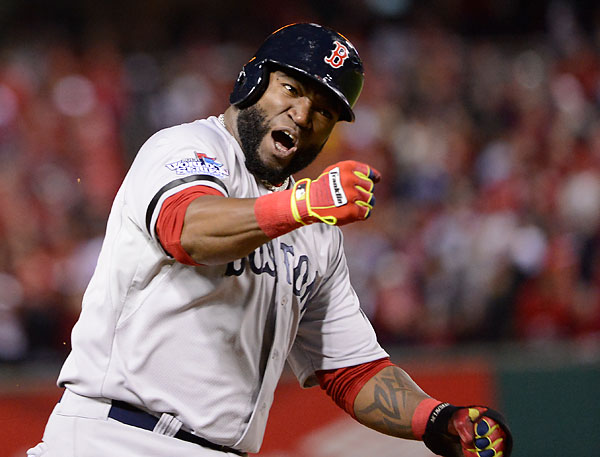


Another great post about the inner workings of being a baseball photographer. Thanks for sharing.